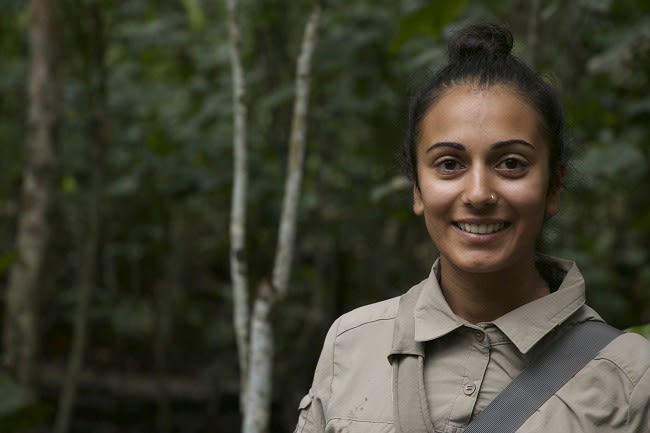Interview with 'Escape' contestant Neera Kukadia
Follow articleHow do you feel about this article? Help us to provide better content for you.
Thank you! Your feedback has been received.
There was a problem submitting your feedback, please try again later.
What do you think of this article?
RS Components talks to promising young female engineer about engineering as a career and her ‘Escape’ experience – the new Channel 4 reality-TV programme
Neera Kukadia
RS has had the exclusive opportunity to catch up with one of the contestants from Escape, the all-new Channel 4 reality-TV series that brings a small group of highly skilled people together to solve engineering challenges whilst in some of the harshest natural environments in the world. Neera Kukadia is an assistant project engineer at Transport for London (TfL), who appeared in the third episode of the series, broadcast on Sunday 15th October 2017. In this interview, she talks to DesignSpark, RS’ engineering community site, with some insight into how she got into engineering, her work as a STEM ambassador, and the challenging experience of trying to escape from a jungle in Panama.
Escape
Produced by Maverick TV for Channel 4, Escape began earlier this month with episodes set in a succession of diverse locations, which, in addition to the jungle in the most recent episode, have thus far included desert and mountainous terrain. Each episode in the series features a different set of engineers, unknown to each other before arriving at their destination. Once there, they have to combine their wits, creativity and know-how in a substantial engineering challenge, while also coping with the extremes of a hostile environment. Each team has to come up with a means of escape, which involves building a vehicle over a number of days using parts and components harvested from vehicles that have been placed as a recreated crash site at each location…. and all before the team’s rations run out. Fortunately, to help the team, along for the ride is series host and survival expert, former Special Forces soldier Ant Middleton, also known for his TV work on Channel 4’s ‘SAS: Who Dares Wins’.
Getting involved in the show
Earlier this year, the opportunity arose for Neera to become a participant in Escape. She had applied to the show and was interviewed, but she comments that it was still a surprise when she was chosen.
“Before the show, I was given limited information: there would be a group of engineers, probably four or five, who would be dropped into a hostile environment. And these engineers would have to rummage around various wreckages and try to build a vehicle from them to try to escape. They also told me it would be in a jungle in Panama, but really not much more.” And regarding the team, “Although, we were flown out on the same plane, we were not introduced until we all met up in the jungle. So we didn’t know each other’s experience or even each other’s names.”
Neera Kukadia (centre) with fellow 'Escape' contestants
“The whole thing was a hugely exhilarating experience, both daunting and exciting at the same time. We started with a ‘health and safety’ briefing, and the first thing we were told about were crocodiles.” According to Neera, the safety measure was the blowing of a horn, telling all they should immediately get to safe ground. Fortunately, they didn’t actually meet any crocodiles!
Challenge
On location, the newly formed team of three women and two men, along with host Ant Middleton, discovered a series of vehicles: a bus, a fire truck, two 4x4s, a builder’s truck, and a motorbike, all wrecked from a simulated flash flood on both banks of a river estuary. “We had to swim to get from one side to another.” Explains Neera: “You couldn’t even get to the vehicles when the tide was at its highest. They were fully submerged, so we only had between six and eight hours per day that we could use the vehicles resourcefully.”
The scene on arrival in Panama
It was obvious early on that some kind of boat was going to be the best option for escape in the jungle environment. “Engineering is all about problem-solving, so it inevitably involves a bit of trial and error. We tried a few things and ended up using a part of the motorbike, which formed the actual rotating shaft in our design. We also found a non-working centrifugal pump in the fire truck. The pump had a rotating shaft, which if rotated would take water into the pump, spin it around and chuck it out. And that essentially was the plan for moving the boat forward. We then needed a means of attaching the motorbike shaft to the pump shaft.”
“I actually thought of RS Components at this stage in the challenge” Neera shares with us. She goes on to explain that she’d recently purchased a shaft coupler from RS for use in an unrelated project called the Railway Challenge, part of the Transport for London graduate scheme. “I remember standing in the jungle thinking about that part and how it would be perfect right now. We ended up using a socket that was the most similar to the coupling, and it became one of the key components in connecting our driveshaft together.”
“We dismissed a few ideas, such as a creating a basic chain drive, as we quickly realised that a chain drive on a boat is not actually a thing, and therefore highly risky. However, we did find a steering column from one of the 4x4s. We connected one side of it to the shaft of the pump and the other to the motorbike shaft and it all rotated in one movement. We had a pipe coming from the inlet and outlet of the pump. When we tried it all out on the very last day, it didn’t work how we wanted it to. It wasn’t powerful enough.”
Just three days into the challenge, the team had already experienced a major setback, when one of the male engineers, who had extensive experience in boat building, sustained an injury and had to come off the show.
Reflections
“At the time” – and given the circumstances – “I thought we’ve done really well, we had managed to get the pump working. But now, afterwards, I keep thinking what if we had done this or done that?” And there was the huge physical challenge, not helped by a lack food, water and sleep. “The heat was bad, but the worst part was dealing with the mud. It goes up to your knees, so it takes up so much energy; to walk five metres took about five minutes. It was so tiring and eventually, it affects your mind. I ended up second-guessing myself about some really basic engineering things. How does that happen?”
Beginning
However, for Neera, this isn’t a story that starts in a Panamanian jungle. The beginning of her highly promising engineering career really started a few years ago with the choice of what to study at university. Neera explains: “I had achieved ‘A’ levels in mathematics, art and ICT (Information Communication Technology), which is an unconventional combination of subjects for engineering. I enjoy mathematics very much, but equally enjoy art because it’s fun and creative. And I think that many people miss the fact that engineering can be highly innovative and creative, especially as there is so much design work in it. I was initially attracted to design engineering, but accredited courses were not really available, so I chose mechanical engineering. A solid degree, but something of a gamble for me not having studied physics. I think my school was surprised by my choice, I don’t think they had really heard of mechanical engineering.”
The gamble paid off; Neera successfully completed four years of a sandwich course studying mechanical engineering at the University of Brighton, including a year working in the industry at a manufacturing company that made valves and pumps. She greatly credits the time working in industry as a major factor in her decision to continue on with a career in engineering. Following the completion of a master’s degree in mechanical engineering, in September 2015, Neera joined the mechanical engineering graduate scheme run by Transport for London (TfL). The scheme is a two-year rotational programme in which graduates essentially change engineering department every three months and get to work in a variety of key areas for TfL, including tracks, rolling stock, general projects, and lifts and escalators. Recently Neera has moved into a more permanent job as a project engineer working on the upgrade of the Northern Line on the London Underground.
STEM

Overall on the experience, Neera concludes: “It was very challenging and difficult. You don’t have a tent or a sleeping bag or have the ability to wash properly. I don’t regret doing it, but I probably wouldn’t jump at the chance to do it again. I did learn a great deal: a lot of engineering principles that you perhaps might never learn in your job. About physical engineering especially, when you put things together and make new things.”
The third episode of ‘Escape’ is now available on catch-up TV via the ALL 4 channel; it is also available, along with episodes one and two, on the Channel 4 website at www.channel4.com/programmes/escape. The next episode of Escape will be shown on Channel 4 on Sunday 29th October at 8 pm.





Comments